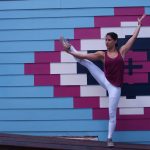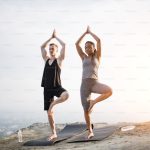My first class at a new studio, and my heart leapt to my throat when the teacher began by saying, “Let’s begin the class with eight rounds of Sun Salutations, the Sivananda style.” Apparently, there are several kinds of Sun Salutation!
I had been practising yoga for about four years when I joined this new uptown studio, but I had only ever practised Sūrya Namaskār (Sun Salutations) in one style. I chose a spot that was the farthest from the instructor and was almost away from his eyes… but not quite. From then on, I’ve armed myself with the knowledge of the various types of Sun Salutation to avoid awkward situations like that! Since the Sivananda variation was the first one I learned, I’ll start by describing that one today — but first let’s talk a bit about the benefits of Sun Salutations.
Sun Salutation Basics
Sūrya means ‘sun,’ and namaskāra means, “Hello,” or “Good morning!” So by practising Sūrya Namaskār we are literally saying good morning to the sun! The Rig Veda (one in a series of four Vedas in Hindu scripture) says that, “Sūrya is the Soul, both of the moving and unmoving beings,” so worshipping the sun became very important, and ultimately rewarding, in Hindu culture.
From a modern scientific standpoint, a 2011 study of Sūrya Namaskār [SN] on the NCBI website found that:
…SN has positive physiological benefits as evidenced by the improvement in pulmonary function, respiratory pressures, hand grip strength and endurance, and resting cardiovascular parameters. It also demonstrates the differences between SN training when performed in a slow and fast manner, concluding that the effects of Fast SN are similar to physical aerobic exercises, whereas the effects of Slow SN are similar to those of yoga training.
In layman’s terms, Sūrya Namaskār is one of those wonderful exercises that provides a multitude of benefits by engaging your entire body. Those benefits shift based on small factors such as speed, pose transitions, or breathing techniques. That’s why several styles of Sun Salutation have been born, out of preference to what benefits you are trying to achieve from the exercise.
In Hindu and Buddhist tradition, it is recommended to practice Sun Salutations 108 times, but if you’re not a die-hard yogi it might be wiser to start with just eight rounds on both sides. No matter the style, it’s always good to finish your practice with a ten minute relaxation to allows your body to absorb the benefits of your practice.
Sūrya Namaskār: The Sivananda Way
Sivananda-style Sun Salutations a specific style of Sun Salutation taught in the Sivananda tradition. It includes twelve classic poses and is a vinyāsa all on its own. It’s very important in this style to match your breaths to your movements. Use the inhalation and exhalation prompts to guide you to the next pose, and to make sure you don’t run out of breath!
The 12 Poses Of Sūrya Namaskār — Sivananda Style
- Tadāsana (Mountain Pose): This pose helps your body find its equilibrium. Stretching yourself completely, with the palms folded into namaste at your heart center.
Inhale. - Hasta Uttanāsana (Raised Arms Pose): You will enter into a subtle backbend while lifting your hands over your head, gaze fixed to the fingertips.
Exhale. - Uttanāsana (Forward Fold): By bowing your head in this forward bend you are showing respect to the sun. The classical variation of this pose sees your palms resting flat on either side of your feet.
Inhale. - Ashwa Sanchalanāsana (Equestrian Pose): Get into the pose by stepping backwards with one leg. Hold your chest and head high, while your fingertips rest on the mat. Since this pose is a variation on a lunge, you could rest the knee of the extended leg for better balance.
Exhale. - Uttihita Chaturanga Dandasana (High Plank Pose): Most of us are familiar with the sensation of making our bodies look like a plank by balancing on our hands and the tips of our toes. This is a core strengthener, but by shifting your awareness slightly, it can also work wonders on your legs.
Hold your breath. - Ashtanga Namaskār (Eight-Limbed Salutation): In Sanskrit, ashta means ‘eight’ and anga means ‘limbs’ or ‘points’. For those who are counting your toes(+2), knees(+2), palms(+2), chest(+1), and chin(+1) will be resting on the mat. Many teachers refer to this posture as Knee, Chest and Chin Posture as practitioners find it easier to follow.
Inhale. - Bhujhangāsana (Cobra Pose): This posture is a mild backbend where your tummy rests on the mat. Allow your forearms and elbows to rest on the mat as you bend back gently.
Exhale. - Adho Mukha Svānāsana (Downward Facing Dog Pose): This pose is another bow to Mother Earth and the sun. Try to keep your legs separated at hip width and push your heels down to the floor. Simultaneously, push the hips towards the ceiling. Spread the palms completely and aligning the wrists right beneath the shoulders will also ensure that you are in the posture.From here we move back to the beginning of the sequence and return to our equilibrium:Inhale.
- Ashwasanchalanāsana (Equestrian Pose)
Exhale. - Uttanāsana (Forward Fold)
Inhale. - Hasta Uttanāsana (Raised Arms Pose)
Exhale. - Tadāsana (Mountain Pose)
Repeat the same with your left side also to complete one round of Sivananda-style Sūrya Namaskār.
How Did I Fare?
Back in class, I had lost my breath by the time we finished the Sun Salutation section, but with consistent practice it’s settled into my body much more easily. Many would say a fast practice gives you more benefits, but I preferred taking it slow at the start. By breathing deeply into each pose, and holding each āsana longer I was more able to enjoy the benefits!
As I mentioned, this is just one of several styles of Sun Salutation that is available to you and we’ll take a look at more of them next time. Each style has slight differences from each other that challenge you in different ways and bring about different benefits. Keep checking back to join me for the next one!












